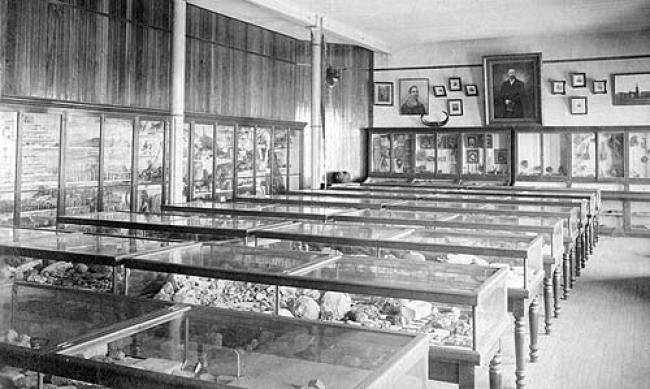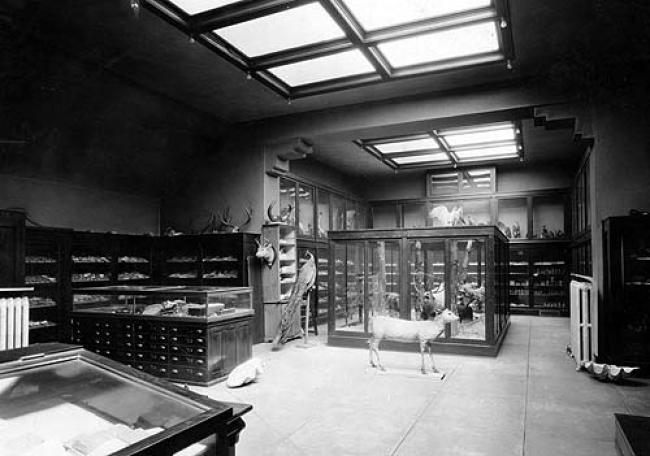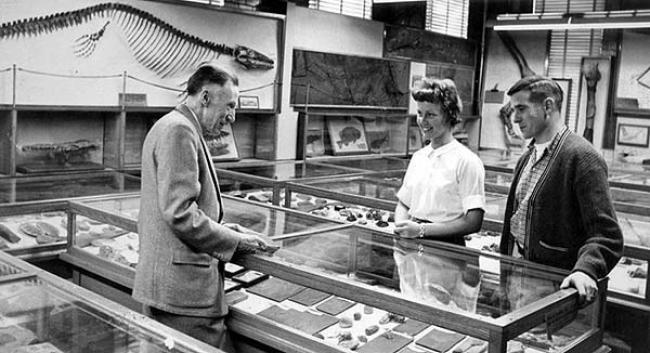'Beyond the pages of the textbooks'
(This story was written in celebration of Augustana's sesquincentennial in 2010.)
Augustana's natural science museums laid a foundation
In 1878 Augustana College and Theological Seminary made a fortunate choice, of lasting consequence, when it hired Josua Lindahl to found the college's Natural Science Department.
He was well known and widely respected at the time as a scholar and museum curator, and Augustana's 21st century strength in the sciences is traceable in many ways to his early efforts to create a strong foundation.

Lindahl brought the college experience and expertise, an outstanding reputation, and a recognition of the growing importance of science to education in the late 19th century. Just as importantly, he was also an excellent teacher who knew that the most successful professor would not just impart knowledge but also inspire.
In an 1886 letter to his former student, J. A. Udden ('81) — then a faculty member at Bethany College — Lindahl wrote:
"It is a well-known fact that...institutions, where the classroom is most excellent but no opportunities are given for waking up the boys to observing or thinking beyond the pages of the textbooks, will invariably fail to turn out men of great ability, whereas other institutions, provided with rich museums, libraries, laboratories, etc., but where the classroom is not even as highly developed as in some one-horse-power institutions will hatch out prominent men in all lines of intellectual work."
He advised Udden that "the very best way, in which both you and I can be useful to our respective schools, is just in making good museums."

Lindahl heeded that advice in his own work at Augustana. He found a small museum already in existence when he arrived at the college in 1878, but he expanded it considerably with contributions from his own research and expeditions.
When Udden replaced Lindahl at Augustana in 1888, Udden inherited a rich zoological, botanical, mineralogical, and numismatic (coin) collection, which he moved to the brand-new Memorial Hall (now Old Main).
During Udden's tenure the museum became much stronger in the area of geology, which was Udden's primary interest. The herbarium, established in 1894, did not survive, and neither did the coin and stamp collections. Yet the museum, in content and design, maintained its teaching function throughout. In a brief study of Udden's tenure at Augustana, William B. Hansen quotes a student of Udden who once declared that the museum's specimens and labels "made up a very good textbook in elementary geology."
The museum moved again in 1911, when Udden, shortly before his departure for a new position in Texas, transferred its contents to the new Denkmann Memorial Library. There — as they had been in Old Main — the scientific and historical artifacts were housed along with the college's collection of rare books and manuscripts. The marriage of museum and library in their own dedicated building seemed perfect, and yet use of the museum decreased. In Old Main, the museum collection had been in close proximity to the science classrooms, while in Denkmann it was not. The science faculty preferred the collections to be contiguous to their classrooms and laboratories.

Thus, by the time Fritiof M. Fryxell ('22) returned to Augustana as a faculty member in 1924, the original museum, the one Lindahl and Udden had cherished and developed, was virtually defunct. Fryxell, who taught geology and founded the college's geology department in 1929, removed some of the original museum's geological and mineralogical specimens, contributed substantially more such specimens of his own, and established a geology museum in Cable Hall of Old Main, where classroom, laboratory, and museum shared the same space. In 1935 the geology department and museum moved to Wallberg Hall, the new science building. In 1968 department and museum moved a final time, to their present home in what is now the Swenson Hall of Geoscience.
Today's Fryxell Geology Museum is not the same museum that Lindahl and Udden developed; the first museum closed and the present one opened, in effect, during the 1920s. Yet a common sense of purpose links the Fryxell Museum to its predecessor. Augustana students, faculty, and staff, as well as local schoolchildren, can and do marvel at the ancient fossils, the fluorescent minerals, and the dinosaur skeleton towering in the front window. The Fryxell Museum "wakes up students to observing or thinking beyond the pages of the textbooks," just as Lindahl and Udden's museum did for students of the late 19th century.
— Stefanie Bluemle ‘02
Reference Librarian
